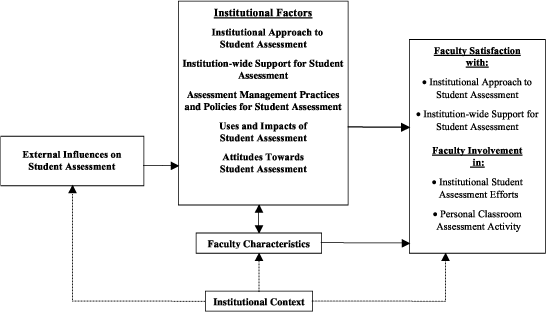Faculty Involvement In, and Satisfaction With, Student Assessment
Phase III of the NCPI national study involved seven institutional case studies during which we gathered empirical evidence to examine faculty involvement in and satisfaction with student assessment. The proposed conceptual model (below), which guided the study, was developed from a literature review that identified factors associated with faculty involvement in and satisfaction with student assessment. The model, borrowing from a prior literature review and model (Peterson, & Einarson, 2000; Peterson, et. al, 2002), identifies institutional factors that may be related to faculty involvement in and satisfaction with institutional and classroom-based student assessment. The primary research question was: What institutional factors are associated with faculty involvement in and satisfaction with their own institution’s student assessment activities and their efforts to support it?
Conceptual Framework for Influences of Faculty Satisfaction with and Involvement in Student Assessment

The study examined the external influences, institutional factors, and
faculty characteristics associated with faculty involvement in their institution’s
and their own classroom student assessment efforts, and associated with
faculty satisfaction with their institution’s approach to and support
for student assessment. Institutional context is included as a potential
exogenous variable. The study used data collected using the Institutional
Climate for Student Assessment (ICSA, 2000) survey, which was designed
to assess respondent perceptions of their institution’s student assessment
patterns and their own satisfaction with and involvement in student assessment
efforts. The dimensions from the external influences and institutional
factor domains (see Characteristics of Domains and Dimensions and Faculty
Attitudes Dimensions) were regressed separately as independent variables
on the four dependent outcomes: satisfaction with institutional approach
to student assessment, satisfaction with institutional support for student
assessment, classroom/instructional involvement with student assessment,
and institutional involvement with student assessment (see Faculty Satisfaction
and Involvement Dimensions). Some of the general findings are outlined
below. For a more detailed examination of the various findings, see Peterson
& Grunwald (2002).
Faculty Satisfaction with Institutional Approach to Student Assessment
(Model explained 39% of variance)
- The number of years worked at the institutions and years worked in higher education were both significant predictors of faculty satisfaction with the institution’s approach to student assessment, although each only accounted for 1% of the model variance and the number of years in higher education had a negative influence.
- Of the institutional factors, using student assessment for internal improvement purposes was the strongest predictor accounting for 29% of the total model variance.
- Student assessment having institutional impacts was a significant
predictor of faculty satisfaction with institution’s approach to
student assessment accounting for 4% of the model variance; as faculty
perceptions of institutional impacts from student assessment increased,
their satisfaction with the institution’s student assessment approach
improved.
Faculty Satisfaction with Institution-wide Support for Student Assessment
(Model explained 46% of the variance)
- Three dimensions were significant in predicting the faculty’s
satisfaction with institution-wide support for student assessment, whether
an institution provides or supports institution-wide activities (4%),
whether student assessment information has any instructional (faculty)
impacts (18%), and whether student assessment is used in making educational
decisions (4%)
Faculty Involvement in Classroom Student Assessment
(Model explained 29% of the variance)
- The strongest predictor of faculty involvement in classroom student assessment is that they believe in the benefits from student assessment, accounting for 20% of the model variance.
- Whether student assessment information is used in faculty-related decisions is significant in predicting faculty involvement in classroom student assessment, however, it only accounts for 3% of the total variance in the model.
Faculty Involvement with Institutional Student Assessment
(Model explained 39% of the variance)
- The strongest predictor of faculty involvement in institutional student assessment is faculty perception that external influences are important, accounting for nearly 24% of the model variance.
- The perception by faculty that their institution provides profession development for student assessment is a significant predictor of a faculty’s involvement in institutional student assessment, accounting for 11% of the model variance.
- Faculty perceiving benefits from student assessment is a significant predictor of faculty involvement in institutional student assessment, accounting for 6% of the total variance in the model.
